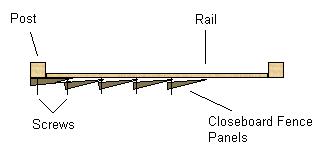There seems to be a wealth of opinions on how best to install a feather edge or close-board fence. Some say screw, some say nail, some say go through both feather-boards, some say go through just the one:



Can someone offer up some reasoning behind each of the options and variations? I'm in the process of erecting about 40m of 6' fence, and would like to know the potential pitfalls. I'm considering screwing the panels as I don't have access to a nail-gun, however if there's a good reason not to, then I won't. Security and durability are the main concerns.



Can someone offer up some reasoning behind each of the options and variations? I'm in the process of erecting about 40m of 6' fence, and would like to know the potential pitfalls. I'm considering screwing the panels as I don't have access to a nail-gun, however if there's a good reason not to, then I won't. Security and durability are the main concerns.

